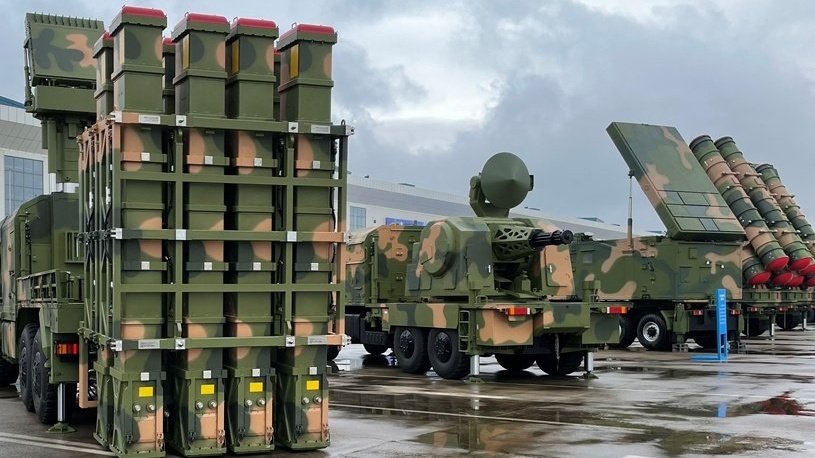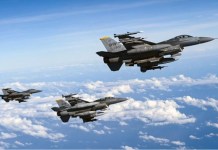Azerbaijan may have acquired the Chinese HQ-9B long-range surface-to-air missile system to bolster its air defense capabilities. The purchase, which is yet to be announced, could mark the second major acquisition of a Chinese platform after the JF-17 Block III fighter, jointly developed by China and Pakistan.
Incidentally, a Transporter Erector Launcher (TEL) vehicle believed to be part of the Chinese-origin HQ-9BE air defense system was spotted in photos and videos ahead of a military parade in Azerbaijan marking the fifth anniversary of Azerbaijan’s victory over Armenia in the Second Nogorno-Karabakh War of 2020.
The photos, widely shared on social media on November 4, were taken during nighttime rehearsals.
The public sighting of HQ-9BE has piqued observers’ interest because neither Azerbaijan nor China has publicly announced Baku’s acquisition of the cutting-edge AD system. Experts pointed out that this is the first time the system was seen in the country and marks the first possible sale of the AD system to Baku.
The EurAsian Times could not independently confirm these reports. However, if true, Azerbaijan would join the small club of countries that have signed up for the long-range air defense system, including Pakistan, Morocco, and Egypt.
Azerbaycan’a ait HQ-9BE hava savunma sistemi görüntülendi. pic.twitter.com/Cr9aUlUloT
— Sanayi ve Savunma 🇹🇷 (@SanayiSavunmaTR) November 5, 2025
Azerbaijan currently operates the Soviet-origin S-300PMU-2 AD system in the long-range category. In addition, the South Caucasian country also has the Tor-M2E, Buk M1, Israeli Spyder, and Barak air defenses, among others.
The HQ-9BE (with a range of about 200-260 kilometers) strengthens Azerbaijan’s defense coverage over Baku, the Caspian coastline, and vital energy infrastructure by offering long-range interception capability.
It would push the operations of the Armenian Su-30 farther away and protect the country against lethal missiles and munitions acquired by Armenia, including Russian-origin Iskander missiles.

It is worth noting that while Azerbaijan has bolstered its air defense with Chinese AD systems, Armenia has acquired the Akash surface-to-air missiles from India. Interestingly, both systems were deployed in combat during the Indo-Pakistan conflict in May 2025.
The reports in Indian media suggest that the HQ-9B proved highly vulnerable to Indian jamming and deception tactics, while the Akash system proved highly effective!
Notably, Azerbaijan’s purchase of the HQ-9B is likely part of a multifaceted military modernisation effort that includes upgrading existing Soviet-origin weapons, acquiring foreign state-of-the-art weapon systems, and developing its local defense industry.
As a former Soviet state, Azerbaijan has historically operated Soviet/Russian military equipment. However, over the past few years, it has been diversifying its military purchases to reduce reliance on any single supplier, such as Russia.
It has forged military ties with Turkey and Israel, and acquired drones and air defense systems from them, respectively. The diversification has also likely been influenced by tensions with Moscow and mistrust over the latter’s treaty obligations towards Armenia.
The Ukraine War and Russia’s production bottlenecks and long delivery delays have further accelerated this process.
This is likely where China comes in, with its cutting-edge weapon systems, shorter delivery timelines, and lower price tag. Until now, Chinese weapons have accounted for only a small fraction of Azerbaijan’s overall arsenal, and SIPRI data shows no major conventional arms transfers from China to Azerbaijan across the five-year period up to 2024. However, the arrival of HQ-9BE suggests that the winds of change have entered the Caucasus.
Earlier, Azerbaijan leveraged its close ties with Pakistan to place an order for the JF-17 Block III fighter jet, which is jointly produced by Pakistan and China. The first confirmation of this purchase came in September 2024 when the aircraft was presented to Ilham Aliyev, the President and Supreme Commander-in-Chief of Azerbaijan, at Heydar Aliyev International Airport.
With this, Azerbaijan became the fourth foreign country to purchase this aircraft after Myanmar, Nigeria, and Iraq.

The HQ-9B Has Reached Azerbaijan
The HQ-9 is a long-range surface-to-air missile (SAM) system developed by China Precision Machinery Import-Export Corporation (CPMIEC). It is designed to intercept a range of aerial threats, including fighter jets, drones, and missiles.
Notably, the HQ-9 is closely related to the S-300, which Azerbaijan currently uses. It was developed using Almaz-Antey technology, incorporating elements from the Russian S-300 missile system. The system entered service in the early 2000s. The HQ-9A variant entered service in 2001, the HQ-9B in 2014.
The HQ-9 is a mobile, truck-mounted system for rapid deployment, using an 8×8 Taian TAS-5380 wheeled chassis for high mobility across varied terrain. It employs a “cold-launch” vertical system, in which missiles eject via gas before ignition, enabling 360-degree firing without launcher orientation.
One HQ-9 battery includes 192 missiles, 48 missile-launch vehicles, six control vehicles, six targeting radar vehicles, six search radar vehicles, a positioning vehicle, a communications vehicle, a power supply vehicle, and a support vehicle.
The system has a Track-via-missile (TVM) system that combines terminal active radar or semi-active radar homing (SARH), mid-course uplink, and inertial guidance. It tracks up to 100 targets using the HT-233 3D phased-array radar.

The HQ-9B has a range of over 260 kilometers, but the export variant’s range may be lower.
The HQ-B can intercept 8 to 10 missiles simultaneously. It has a dual seeker that improves hit probability against low-observable or ECM-heavy targets, while datalinks enable mid-course updates from external sensors.
Often compared to Russia’s S-400 due to its extended range and multi-target engagement, the HQ-9B emphasizes mobility, radar resilience, and integration into layered defense networks.
In fact, the Chinese state media have previously said the HQ-9B is comparable to the US-origin Patriot missile defense system. Both are long-range, multi-role SAM systems designed for area defense, protecting critical infrastructure, and countering threats like fighters, bombers, drones, cruise missiles, and ballistic missiles.
Chinese media regularly highlight the HQ-9’s performance in local and international exercises, noting that it has a high interception rate in simulated scenarios. For instance, the PLA Air Force exercises have demonstrated the HQ-9’s capability to engage low-flying targets, hypersonic threats, and saturation missile attacks.
- Contact the author at sakshi.tiwari13 (at) outlook.com
- Follow EurAsian Times on Google News




